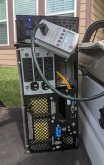Delmar
Solar Addict
My beloved UPSverter worked perfectly with my golf cart 48V FLA battery set. Later added solar panels to the cart which also worked perfectly with the battery set.
Then tested the UPSverter while using the solar panels. Not so perfect. Whenever the battery climbed above 53V the UPS started blinking indicating higher than expected battery voltage. Later it would rarely pass the self-test and boot.
Since I can no longer trust the UPS replaced with a 2500W Reliable simply because it’s one of the lowest priced pure sine inverters. Cost was $257+ $21 tax and free shipping = $278 to my door. Only need for grid down so hopefully will never use it, if I were using daily I would get something more…well…reliable.
The 2500W vs 2700W capacity will make a good apples-apples comparison. Following is a size comparison with the Reliable sitting on the UPSverter. Weight reduction was 90lbs (even without batteries) vs 16 lbs. My old back greatly appreciates the lighter weight.


Repeated my fridge power test that draws only 110 watts AC which is minimal loading, however is the most critical appliance during a hurricane extended grid-down:
Next test…connecting the inverter to my breaker panel having bonded neutrals. I’m concerned with some Reliable inverters having a live neutral and smoking when bonded. That was the exclusive reason I initially purchased the UPS. I’ll connect to the panel before powering the inverter, and keep a fire extinguisher nearby. Wish me luck.
Then tested the UPSverter while using the solar panels. Not so perfect. Whenever the battery climbed above 53V the UPS started blinking indicating higher than expected battery voltage. Later it would rarely pass the self-test and boot.
Since I can no longer trust the UPS replaced with a 2500W Reliable simply because it’s one of the lowest priced pure sine inverters. Cost was $257+ $21 tax and free shipping = $278 to my door. Only need for grid down so hopefully will never use it, if I were using daily I would get something more…well…reliable.
The 2500W vs 2700W capacity will make a good apples-apples comparison. Following is a size comparison with the Reliable sitting on the UPSverter. Weight reduction was 90lbs (even without batteries) vs 16 lbs. My old back greatly appreciates the lighter weight.


Repeated my fridge power test that draws only 110 watts AC which is minimal loading, however is the most critical appliance during a hurricane extended grid-down:
- APC UPSverter would draw around 4.5A @ 50V = 225W. Not efficient at all with low load.
- Reliable would draw around 2.5A @ 50V = 125W. When the fridge was disconnected the no-load amps was 0.4A = 20W. Very impressive, I almost doubled my battery runtime.
Next test…connecting the inverter to my breaker panel having bonded neutrals. I’m concerned with some Reliable inverters having a live neutral and smoking when bonded. That was the exclusive reason I initially purchased the UPS. I’ll connect to the panel before powering the inverter, and keep a fire extinguisher nearby. Wish me luck.


